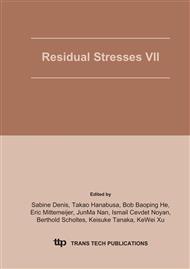[1]
www. sfb483. uni-karlsruhe. de.
Google Scholar
[2]
E. Macherauch, P. Müller: Das sin²ψ Verfahren der röntgenographischen Spannungsmessung. Z. angew. Phys. 13, (1961), 305-312.
Google Scholar
[3]
T. Leverenz, B. Eigenmann, E. Macherauch: Das Abschnitt-Polynom-Verfahren zur zerstörungsfreien Ermittlung gradientenbehafteter Eigenspannungszustände in den Randschichten von bearbeiteten Keramiken. Z. Metallkde., 87 (1996) 616-625.
DOI: 10.1515/ijmr-1996-870802
Google Scholar
[4]
B. Ballard, X. Zhu, P. Predecki, D. Brask: Depth profiling of residual stresses by asymmetric grazing incidence X-ray diffraction (GIXD). Proc. Fourth Int. Conf. On Residual stresses, ICRS4, Soc. Exp. Mech., Bethel (1994), 1133-1143.
DOI: 10.1007/978-1-4615-2972-9_28
Google Scholar
[5]
H. Dölle, V. Hauk: Röntgenographische Spannungsermittlung für Eigenspannungssysteme allgemeiner Orientierung. HTM 31 (1976) 165-168.
DOI: 10.1515/htm-1976-310307
Google Scholar
[6]
A. Arslan, A. Albers: Potenziale ingenieurkeramischer Werkstoffe für die Anwendung im trockenen Friktionssystem. Tribologie Fachtagung 2002, GfT, Gesellschaft für Tribologie e.V., Göttingen (2002).
Google Scholar
[7]
T. Erbacher, T. Beck, O. Vöhringer: The Behaviour of Alumina Ceramics under Tribological Loading, in Proceedings MaterialsWeek 2002, ISBN 3-88355-314-X, Mat Info, Frankfurt/Main (2003).
Google Scholar
[8]
K. Poser, J. Schneider, K. -H. Zum Gahr: Keramik/Metall-Friktionspaarungen unter ungeschmierter Gleitbeanspruchung bei erhöhten Temperaturen. Tribologie Fachtagung 2002, GfT, Gesellschaft für Tribologie e.V., Göttingen 2002, S. 14/1-14/10.
DOI: 10.1002/mawe.200400809
Google Scholar
[9]
T. Erbacher, T. Beck, O. Vöhringer: Einfluß trockener Friktionsbeanspruchungen auf das Schädigungsverhalten, Restfestigkeit und Oberflächeneigenspannungen von Al2O3. Mat. -wiss. u. Werkstofftech. 34 1/2003 Wiley-VCH, ISSN 0933-5137, S. 152-161.
DOI: 10.1002/mawe.200390008
Google Scholar


